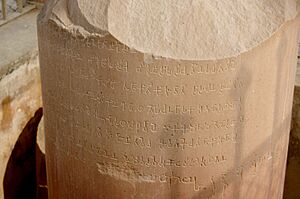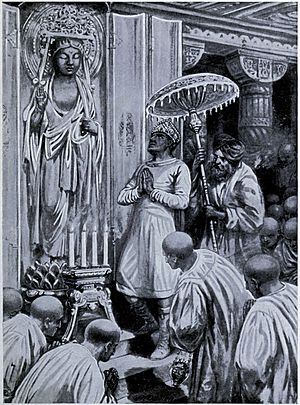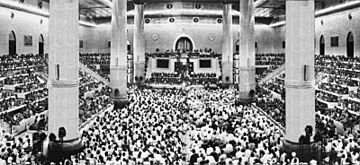Buddhist councils facts for kids
Since the death of the historical Buddha, Siddhartha Gautama, Buddhist monastic communities ("sangha") have periodically convened to settle doctrinal and disciplinary disputes and to revise and correct the contents of the Buddhist canons. These gatherings are often termed Buddhist "councils" (Pāli and Sanskrit: saṅgīti, literally meaning "reciting together" or "joint rehearsal"). Accounts of these councils are recorded in Buddhist texts as having begun immediately following the death of the Buddha and have continued into the modern era. The earliest councils are regarded as real events by every Buddhist tradition. However, the historicity and details of these councils remains a matter of dispute in modern Buddhist studies. This is because various sources belonging to different Buddhist schools contain conflicting accounts of these events and the narratives often serve to bolster the authority and prestige of specific schools.
Contents
First Buddhist Council
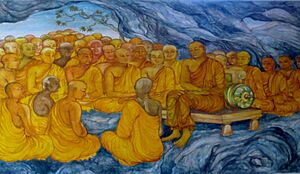
The first Buddhist council is traditionally said to have been held just after Buddha's final nirvana. It was led by Mahākāśyapa, one of his most senior disciples. The meeting took place at a cave near Rājagṛha (today's Rajgir). King Ajatashatru supported this gathering.
Its main goal was to preserve the Buddha's sayings (suttas) and the monastic rules (Vinaya). The Suttas were recited by Ananda. The Vinaya was recited by Upali. The Buddha had said the Sangha could change minor rules after his passing. However, the council decided to keep all the rules as they were. Many scholars today question if this first council happened exactly as described.
Numerous Vinayas (rule books) also show disagreements at the first council. Monks argued about whether to keep or remove some minor rules. Some monks even wanted to abolish all minor rules. Also, many early sources say that Mahakasyapa criticized Ananda in different ways. This suggests there might have been "actual conflict between two contending factions" after the Buddha’s death. The more strict group seems to have won.
According to some traditional accounts, 499 of the Buddha's top arhats (enlightened ones) were chosen to attend. Ananda, who was not yet an arhat, trained himself. He became an arhat by the dawn of the council day. Then he was allowed to join.
Modern scholars believe the Abhidhamma Pitaka, the third main part of the Tipitaka, was written later. This is due to its content and different language style. However, Theravada tradition says the Abhidhamma Pitaka was also included at the first Buddhist council. They believe it was authored by Sāriputta.
Alternative Groups
Various Vinayas also tell of another interesting event from this time. The Cullavagga mentions an arhat named Purāṇa. He said he and his followers preferred to remember the Buddha's teachings in the way he had heard them. So, they did not rely on the council's collections. This figure also appears in other texts. These texts show Purāṇa and another monk, Gavampati, were not at the council. They worried about what would happen to the Dharma after the Buddha's death.
Chinese sources also describe a similar event. According to these, an alternative collection of texts was put together. It was called the Mahasamghikanikaya (Collection of the Great Assembly). It was compiled by an Arhat named Baspa and his followers.
Historicity
Several modern scholars doubt if the entire Buddhist canon was truly recited during the First Council. This is because early texts contain different accounts on important subjects. However, it may be that early versions of the Vinaya-piṭaka and Sutta-piṭaka were recited.
Many scholars, from the late 19th century onward, have considered the historicity of the First Council unlikely. Some thought there must have been assemblies after the Buddha's death. But they only considered the main characters and some events historical. Other scholars believe the account of the First Council was written after the Second Council. They think it was based on the second council's story. This is because there were no major problems to solve after the Buddha's death.
On the other hand, some scholars think the account of the First Council was real. They point to similarities between the Pāli texts and the Sanskrit traditions. One scholar, Richard Gombrich, believes that "large parts of the Pali Canon" do date back to the first council.
Second Council and First Schism
Second Council
Historical records for the Second Buddhist Council come mainly from the Vinayas of various schools. It was held 100 years after the parinirvana of Buddha. It took place in the Valukarama of Vaiśālī. King Kalashoka supported it.
While details differ, these schools agree that monks at Vaisali were accepting money. They were also following other relaxed practices. This caused a controversy when other monks found out. These relaxed practices are often called "ten points." The main issue was accepting money from laypersons. A monk named Yasa Kākandakaputta first noticed these practices. He alerted other elders and called out the monks. In response, monks from Vaiśālī and Yasa gathered senior members of the Sangha. They met to fully settle the issue. This dispute about vinaya, according to traditional sources, resulted in the first schism (split) in the Sangha. But some scholars think a schism did not happen at this time. They believe it happened later.
First Schism
Vinaya Dispute
The Cullavagga of the Pali Canon of Theravāda Buddhism says the Vaiśālī (Vajjiputtakā) monks practiced ten points (dasa vatthūni) that went against the Vinaya rules. These included:
- Storing salt in a horn.
- Eating food when the sun's shadow had passed two fingers' breadth beyond noon.
- Eating once and then going again to the village for alms.
- Holding the uposatha (observance day) separately by monks in the same district.
- Carrying out an official act when the assembly is incomplete.
- Following a practice because one's teacher does it.
- Eating sour milk after having had a midday meal.
- Using strong drink before it has fermented.
- Using blankets with unstitched hems.
- Accepting gold and silver.
The orthodox monks refused to agree to these points. One of their leaders, Yasa Kākandakaputta, publicly condemned the Vajjiputtakas. After much discussion, the Ten Points were declared invalid. This decision was told to the monks. Soon after, a recitation of the Doctrine was held. Seven hundred monks took part.
The Vajjiputtakas refused to accept this decision. They formed a separate group, the Mahāsanghikas. They had their own recitation. So, Theravāda Buddhism suggests that Mahāsāṃghikas tried to change the traditional Vinaya by adding the above ten points.
However, Mahāsāṃghikas say that the Sthaviras ("Elders") wanted to 'add' more rules to the Vinaya. Vinaya texts linked to the Sthaviras do have more rules than those of the Mahāsāṃghika Vinaya. The Mahāsāṃghika Pratimokṣa (list of rules) has 67 rules in one section, while the Theravāda version has 75 rules. The Mahāsāṃghika Vinaya discusses how the Mahāsāṃghika disagreed with the Sthavira 'additions' to the Vinaya.
Due to the conflicting claims from both groups, a clear conclusion cannot be reached. It is hard to say whether the Sthaviras' or the Mahāsāṃghikas' Vinaya was the original.
The Mahādeva Episode and the "Five Points"
An alternative view of what caused the first schism is found in several Sthavira sources. This includes the Theravada Dipavamsa. According to these sources, about 35 years after the second council, another meeting happened in Pāṭaliputra. This meeting was called to dispute five points held by a figure named Mahādeva. These five points generally describe arhats as imperfect and able to make mistakes. Sthavira sources claim the schism was caused by Mahādeva. He is often shown as an evil figure. The "five points" describe an arhat as still having impurity, ignorance, doubt, needing guidance from others, and speaking of suffering while in deep meditation.
According to the Sthavira accounts, the majority (Mahāsaṃgha) sided with Mahādeva. A minority of righteous elders (Sthaviras) opposed it. This caused the first split in the Buddhist community. According to this account, Mahadeva was criticized by Sthavira elders. He eventually became the founder of the Mahāsāṃghika school. Mahasamghika sources do not claim Mahadeva as a founder. They do not agree with this account. As such, most scholars think the Mahādeva incident was a later event. They believe it was not the root cause of the first schism.
Some scholars have concluded that linking "Mahādeva" with the first schism was added later. It was based on much later events.
Theravada Accounts of a Third Council
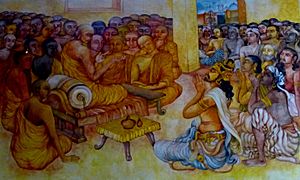
Theravada sources tell stories of a Third council of the Theravara school. It happened during the reign of Ashoka. This was at Pataliputra, emperor Ashoka's capital.
According to Theravāda commentaries and chronicles, the Third Buddhist Council was called by the Mauryan king Ashoka. It was held at Pātaliputra (today's Patna). The elder Moggaliputta Tissa led it. Its goal was to purify the Buddhist movement. This was especially from groups who joined only for the royal support. Because of increased royal support, many unfaithful, greedy men with wrong views tried to join the order improperly. This caused many divisions. Because of this, the third council of one thousand monks was called. Moggaliputtatissa led it. The emperor himself was there. He asked the suspect monks what the Buddha taught. They claimed he taught wrong views. He asked the virtuous monks. They replied that the Buddha was a "Teacher of Analysis" (Vibhajjavādin). Moggaliputta Tissa confirmed this answer.
The Theravadins say the council then recited the scriptures. They added Moggaliputta Tissa's own book, the Kathavatthu, to the canon. This book discusses various dissenting Buddhist views and the Vibhajjavādin responses to them. Only Theravadin sources mention this text. According to this account, this third council also seems to have led to the split between the Sarvastivada and the Vibhajyavāda schools. This was over the issue of the existence of the three times (past, present, future).
The Ashokan Missions
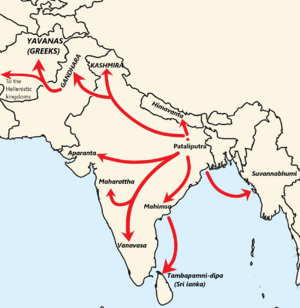
Theravada sources mention that another function of this council was to send Buddhist missionaries to various countries. This was to spread Buddhism. These missions reached as far as the Hellenistic kingdoms in the West. They also went to South India, Sri Lanka, and Southeast Asia. The fact that the Buddhist community was heavily involved in missionary activities across Asia at Ashoka's time is well supported by archeological sources. This includes many Indian inscriptions that match the claims of the Theravada sources.
Some of these missions were very successful. For example, those that established Buddhism in Afghanistan, Gandhara, and Sri Lanka. Gandharan Buddhism, Greco-Buddhism, and Sinhalese Buddhism continued to be very influential traditions for generations. The missions to the Mediterranean Greek kingdoms seemed less successful. However, some scholars believe it is possible some Buddhist communities were established for a limited time in Egyptian Alexandria.
The Two "Fourth Councils"
By the time of the Fourth Buddhist Councils, Buddhism had split into different schools in different regions of India. Scholars have also questioned the historicity (if they truly happened) of these councils.
Sinhalese Theravāda
The Southern Theravāda school had a Fourth Buddhist Council in the first century BCE. It was in Sri Lanka at Alu Vihāra (Aloka Leṇa). This happened during the time of King Vattagamani-Abhaya.
At this time, the Pali texts were only spoken and memorized. They were kept in several versions by dhammabhāṇakas (Dharma reciters). The surviving monks realized the danger of not writing it down. If the monks who remembered parts of the Canon died, the teachings would be lost. So, they decided to write them down.
Kashmiri Sarvāstivāda
Another Fourth Buddhist Council was held by the Sarvastivada tradition in the Kushan empire. It is said to have been called by the Kushan emperor Kanishka I (around 158–176 CE). It took place in 78 AD at Kundalvana vihara in Kashmir.
The Fourth Council of Kashmir is not recognized as official by the Theravadins. Reports of this council can be found in scriptures kept in the Mahayana tradition. It is said that Emperor Kanishka gathered 500 Bhikkhus in Kashmir. They were led by Vasumitra. Their goal was to organize the Sarvastivadin canon. These texts were translated from earlier local languages (like Gandhari) into Sanskrit. It is said that during the council, 300,000 verses and over nine million statements were put together. This process took twelve years to complete. Sarvastivada sources also claim that the huge Abhidharma Mahāvibhāṣa Śāstra ("Great Abhidharma Commentary") dates to Kanishka's time. This massive text became central to the Vaibhāṣika tradition in Kashmir. Even though the Sarvastivada are no longer an independent school, their Abhidharma tradition was passed on to the Mahayana tradition.
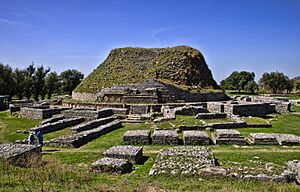
Theravada Councils in Myanmar
Fifth Burmese Council (1871)
Another Buddhist Council, led by Theravada monks, took place in Mandalay, Burma, in 1871. This was during the reign of King Mindon. In the Burmese tradition, it is commonly known as the "Fifth Council." The main goal of this meeting was to recite all the teachings of the Buddha. They wanted to examine them in great detail to see if any had been changed, distorted, or dropped.
Three Elders led it: the Venerable Mahathera Jagarabhivamsa, the Venerable Narindabhidhaja, and the Venerable Mahathera Sumangalasami. About 2,400 monks joined them. Their joint Dhamma recitation lasted for five months. This council also approved the entire Tripitaka to be carved onto 729 marble slabs. These were written in the Burmese script. This monumental task was done by monks and skilled craftsmen. Once each slab was finished, they were housed in beautiful miniature 'pitaka' pagodas. These are on a special site at King Mindon's Kuthodaw Pagoda at the foot of Mandalay Hill. This is where it and the so-called 'largest book in the world' stand today. This council is not generally recognized outside Burma.
Sixth Burmese Council (1954)
The Sixth Council was called at Kaba Aye in Yangon (formerly Rangoon) in 1954. This was 83 years after the fifth one in Mandalay. The Burmese Government, led by Prime Minister U Nu, sponsored it. He authorized the building of the Maha Passana Guha, the "great cave." This was an artificial cave much like India's Sattapanni Cave, where the first Buddhist Council had been held. The Council met on May 17, 1954.
As with the previous councils, its first goal was to affirm and preserve the genuine Dhamma and Vinaya. However, it was unique because the monks who took part came from eight countries. These 2,500 learned Theravada monks came from Myanmar, Thailand, Cambodia, Laos, Vietnam, Sri Lanka, India, and Nepal. Two Western monks, Venerable Nyanatiloka Mahathera and Venerable Nyanaponika Thera, also attended. They were invited from Sri Lanka. The late Venerable Mahasi Sayadaw was given the task of asking questions about the Dhamma. The Venerable Bhadanta Vicittasarabhivamsa answered all of them wisely and well. By the time this council met, all participating countries had translated the Pali Tripiṭaka into their native scripts, except for India.
The traditional recitation of the Buddhist Scriptures took two years. The Tripiṭaka and its related literature in all the scripts were carefully examined. Their differences were noted, and necessary corrections were made. All versions were then compared. It was found that there was not much difference in the content of any of the texts. Finally, after the council officially approved them, all the books of the Tipitaka and their commentaries were prepared for printing on modern presses. They were published in the Burmese script. This notable achievement was made possible by the dedicated efforts of the 2,500 monks and many lay people. Their work ended on the evening of Vesak, May 24, 1956. This was exactly two and a half millennia after Buddha's Parinibbana, according to traditional Theravada dating.
Theravada Councils in the Thai Tradition
The Thai Theravada tradition has a different way of counting the history of Buddhist councils. It names many other councils besides the ones listed above. A common Thai historical source for the early councils is the Saṅgītiyavaṁsa (around 1789).
The first three councils are the traditional councils in India (1. Rājagaha, 2. Vesālī, 3. Patāliputta).
The fourth council is seen by the Thai tradition as having taken place under the reign of King Devānampiyatissa (247–207 BCE). This was when Buddhism was first brought to Sri Lanka. It was supposed to have been held under the leadership of the Venerable Ariṭṭha.
The fifth council, according to the Thai tradition, is that of King Vattagāmanī Abhaya. This was when the Pali Canon was first written down in Sri Lanka in the first century BCE at Āluvihāra.
The sixth council, according to the Saṅgītiyavaṁsa, includes the activities of the Pāli translation of the Sinhalese commentaries. This project was led by Ācariya Buddhaghosa.
The seventh council is believed to have taken place during the time of the Sri Lankan king Parākkamabāhu I. It was led by Kassapa Thera in 1176. During this council, the Atthavaṇṇanā was written. This text explains Buddhaghosa's Pāli translation of the original Sinhalese commentaries. Parākkamabāhu also united the Sri Lankan sangha into one single Theravada community.
Councils Held in Thailand
From this point onwards, the Thai tradition focuses on councils held in Thailand. These were supported by the Thai monarchy.
The first of these was held in the Mahābodhārāma at Chiang Mai. Several monks attended. The Mahāthera Dhammadinnā presided over the council. The King of Lan Na, Tilokaraj (ruled 1441–1487), supported it. During this council, the spelling of the Thai Pali Canon was corrected. It was written in the Lan Na script. This council was held in 1477 CE.
A second Thai council was held in Bangkok from November 13, 1788, to April 10, 1789. It was supported by King Rāma I and his brother. 250 monks and scholars attended. A new edition of the Pali Canon was published, the Tipitaka Chabab Tongyai.
The third Thai council was held in 1878 during the reign of King Chulalongkorn (Rama V). During this council, the Thai script was used to make copies of the Pali Canon. The canon was published in modern book form for the first time.
The next Thai council was held in Bangkok during the reign of Rama VII (1925–1935). This council saw a new edition of the Pali Canon published in the Thai script. This edition was distributed throughout the country.
See also
- Ecumenical council
- Index of Buddhism-related articles
- World Fellowship of Buddhists


